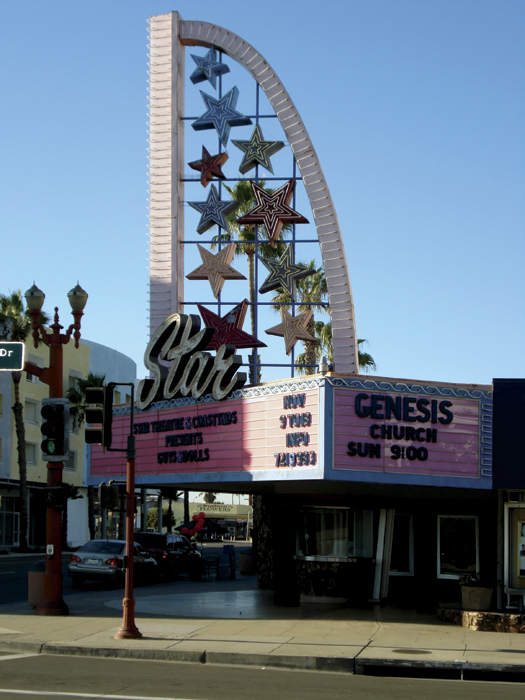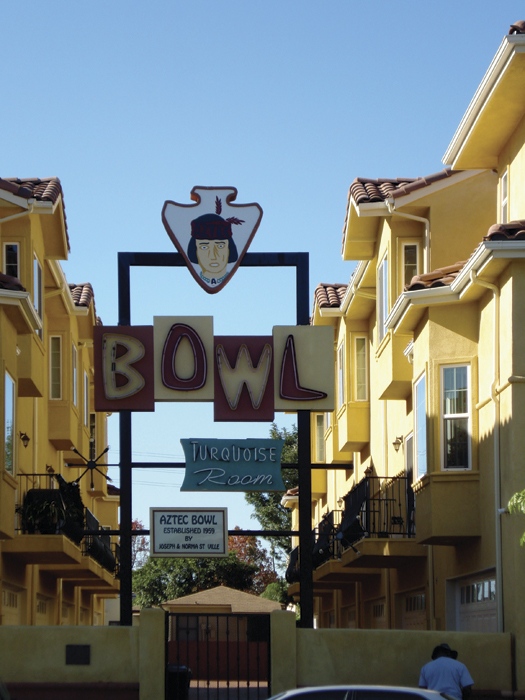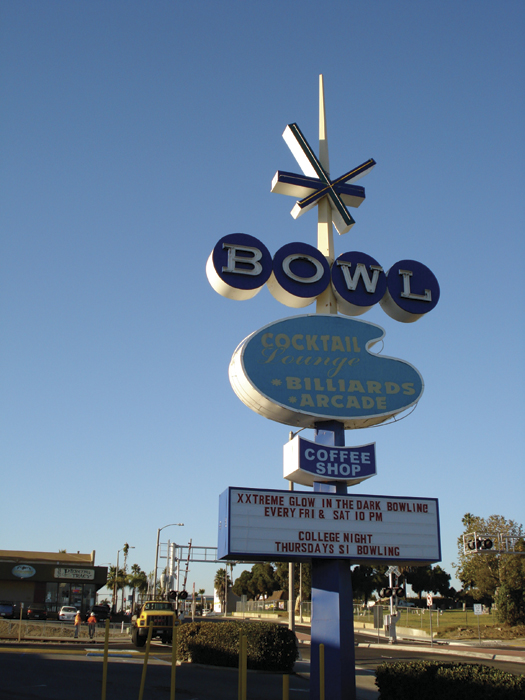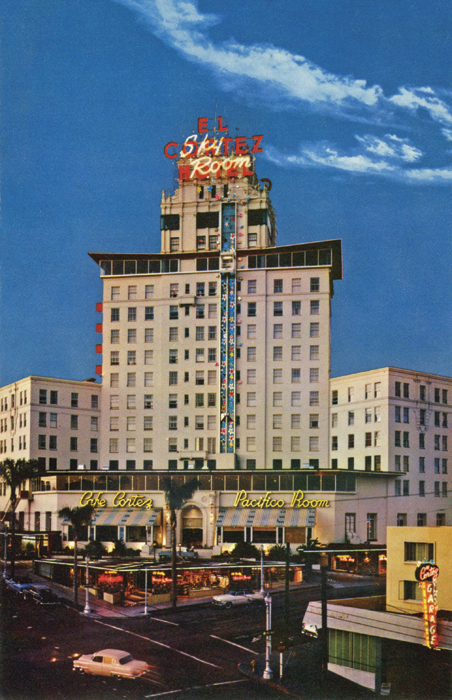|
Googie:
An Architectural Link to San Diego's Midcentury Culture
By Kristin Reichardt Kirwan

The Star Theater, with its soaring, glittering mast, is one of Oceanside's Googie relics.
|

The bulging, angular letters of the Aztec Bowl sign are typical of the Googie style. The bowling alley itself, however, no longer stands.
|

The toothpick-shaped pylon of the Surf Bowl still beckons groups of bowlers to its lively alleys.
| 
The El Cortez Hotel with neon Sky Room sign, Starlight Express elevator, and the angled roof lines of the 1956 Starlight Room since removed.
|
Here's a pop quiz for longtime residents and architecture buffs of San Diego: What architectural common denominator do the pre-renovation El Cortez Center, the former Aztec Bowl on 30th Street in North Park, and Oceanside's Surf Bowl and Theater share?
With their upswept roofs, bold angles and starburst shapes on their signs, these landmarks are classic examples of Googie architecture, the dramatic, pluralistic, and sometimes maligned style that first flourished in the 1950s and 60s in the form of Southern California coffee shops and bowling alleys, then spread across the nation. Here, the post and beam aspired skyward; roofs slanted as if suspended in the sky. A typical Googie interior, meanwhile, featured more organic elements: terrazzo floors, rock (or so-called "flag-crete") accent walls, and tropical leafy plants. Coffee shops, with staccato names like Ship's, Biff's, and Kit's, were not the uniform, green-awninged franchises of today; architecture critic Alan Hess, author of Googie Redux: Ultramodern Roadside Architecture, describes them as places where "Fred Flintstone and George Jetson could meet over a cup of coffee." Similarly, Googie-era bowling alleys were spacious, mid-century public centers that served as much for relaxing and socializing as for racking up strikes and spares.
As Southern California orange groves were being bulldozed to accommodate postwar suburban development, Googie architecture popularized the emerging industries of aerospace and the automobile. The vast plate glass windows of Googie buildings functioned as paeans to the automobile in that they effectively broke down inside/outside barriers: the car was not to be hidden or ignored. Today's best example of retro-Googie architecture, the In-n-Out Burger chain, was California's first drive-through. Meanwhile, Southern California in the 1950s was also ground zero for aircraft and aerospace development and manufacturing. Other aerodynamically eye-catching forms, including signs with starburst shapes and lettering that was both bulging and angular, reflected the clean and shining surfaces of rocket ships during the USA-USSR space race.
Locally, companies including Convair and Ryan Aeronautical distinguished San Diego as a leader in the aerospace industry. While Los Angeles and Orange County may have been Googie's epicenter, our city boasted its own treasures, some of which continue to be landmarks. In 1956, downtown's El Cortez Center was adorned with the glittering Starlight Express elevator, an exterior column of glass that whisked passengers up to the Starlight and Sky Rooms, whose angled wings, now removed, tilted up to the heavens. Another Googie creation of 1956 was Oceanside's Star Theater (note the recurring celestial theme). With Moby Dick as its inaugural feature, the bespangled Star boasted the largest marquee in San Diego County. Finally, two local bowling alleys, one demolished, one still very active, continue to impart their retro-futuristic character to local streets. The actual structure of the former, the Aztec Bowl on 30th Street, is no more, having been replaced by, surprise, condominiums, but the pointy letters and starbursts of its surviving sign testify to an earlier, more dynamic glory. The prominent sign outside the latter, Oceanside's Surf Bowl, hits the Googie trifecta, with an otherworldly amoeba, a spiky starburst and a tapering vertical pylon. For more examples of San Diego Googie, seek out neighborhoods that are yet to experience urban renewal: along El Cajon Boulevard, or the Oceanside stretch of 101. The humbler Googie structures of these areas, often in the form of office buildings and liquor stores, may not evoke the clean lines and pure forms of other mid-century architecture, but are rarely boring or repetitive.
Just as compelling as the arguments for its preservation was the criticism directed against Googie. Firstly, its unashamed commercialism and reflection of popular tastes were enough to stoke the bias against it. Furthermore, many architectural critics preferred a minimalist aesthetic, in contrast to what they saw as Googie's "arbitrary flamboyance." Alan Hess compares these critics to "missionaries condemning the immorality of Tahitian natives who failed to dress for dinner." Finally, many distinctive Googie features: eaves, pylons with circular cutouts, were crafted for aesthetic value only and did not necessarily express the actual structure, leading Modernist purists to dismiss Googie as "dishonest," or a "corruption" of Modernism. The ornate nature of Googie violated the Modernist preference for minimalism and functionalism.
Like art deco, Googie was undervalued until many of its finest designs had been destroyed or permanently maimed. Some of its skyward-slanting roofs were relegated to junkyards, as was the final destination of the soaring, angled pylons of the Laurel Canyon Car Wash in the San Fernando Valley. Others were handed an equally inglorious fate: they were replaced in the 1970s by painfully dull mansard/Spanish Revival hybrid roofs. These unfortunate "restorations" were a result of attempts by well-meaning but uninformed organizations to preserve historically significant structures without first hiring a preservation architect or consultant. The namesake of the Googie style itself, a 1948 Los Angeles coffee shop, was demolished in the 1980s.
To be sure, not all Googie is great architecture, but the best designs reflected their culture, function, and geography as capably and colorfully as any architectural style. Preserving these examples results in streets that are richer in character and variety, and for San Diego, also honors a crucial period of our city's industrial history. Additionally, it was arguably no accident that this populist, pluralistic style reflected these establishments' role as gathering places for community life, opportunities that are increasingly difficult to find today. As an architectural manifestation of the era, therefore, it would be difficult to argue how preservation of better-received regional styles (the bungalow house, for one), would be more important in terms of capturing Southern California history.
Of the lost theatres, by far the most fascinating is the Airdrome, an outdoor theatre, which opened July 10, 1910, on the northwest corner of D Street (now Broadway) and Third Street (now Third Avenue) for a few months.
Author Kristin Reichardt Kirwan is a native San Diegan and a freelance writer specializing in topics related to architecture, design, and history. She lives in Carlsbad with her husband and daughter. Photos are by the author; El Cortez historic postcard image courtesy Sandé Lollis
|
MORE FROM THIS ISSUE
From the Editor
The Balboa Theatre - Anatomy of a Restoration
The Balboa Theatre - An 18-year redevelopment battle
Survivors of San Diego's Theatrical Past
Professional Theater Comes to San Diego
Googie: An Architectural Link to San Diego's Midcentury Culture
North Park's Neon
A General Plan of Destruction
Unearthing Long-Buried Whaley House Cistern
Preservation Community
Reflections
Lost San Diego
Strength in Numbers
Donations 2007-2008
Advertisements
DOWNLOAD full magazine as pdf (16mb)
|







